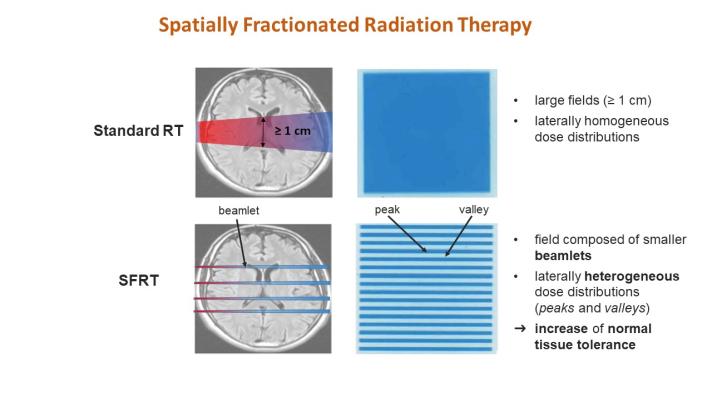Context and project goal
Radiotherapy (RT) is one of the most frequently used methods for cancer treatment (above 50% of patients will receive RT). Despite remarkable advances, normal tissues tolerances continue to be the main limitation in RT.
To overcome this limitation, the project proposes to explore new techniques based on novel dose delivery methods and different particle types. The goal is to identify the optimal use of spatially fractionated radiation therapy (SFRT), which would target the disease without impacting surrounding tissue.
To achieve this, the team has worked on specific dosimetry protocols, which include the determination of correction factors for high-resolution detectors. Additionally, they work on the optimisation of the extraction system and beamline elements of cyclotron-based proton therapy centres to enable the generation of magnetically focused proton minibeams.
The project also performs dosimetry studies of an optimised form of GRID therapy. The small field sizes used and computer generated 3D structures require important calculation resources, that only HPC allows to perform.
This project is run by New Approaches in Radiotherapy (NARA), a cross-disciplinary and international group operating at the intersection of medical physics, computing, and radiobiology. NARA is a team pioneering the conception and development of innovative methods based on the use of the spatial fractionation of the dose. This strategy has already shown a remarkable reduction in side effects of the radiation.
Computational Methods
To accomplish their objectives, the team relies on MonteCarlo simulations, specifically using codes such as TOPAS, which are well-suited for medical physics research. These simulations are crucial for understanding and predicting the behaviour of radiation in complex treatment scenarios.
Technical Challenges
One of the significant technical challenges of achieving effective simulations was the need for nanometric resolutions. This requirement requires increased computational time and memory usage, making access to high-performance computing resources crucial for the project's success.
Societal impacts
This pioneering project has significant societal impact, offering a completely innovative approach to radiotherapy. By generating safer and more efficient treatments, the new techniques could reduce side effects compared to traditional RT methods. Clinical trials in proton minibeam radiotherapy are run by the Institut Curie, highlighting the real-world potential of this research.
Employment and future utilisation of EuroHPC resources
The intense computational demands, particularly for in proton minibeam radiotherapy research, has necessitated access to large clusters like those provided by EuroHPC. EuroHPC supercomputers will continue to be available to teams like NARA to perform these health related simulations.
